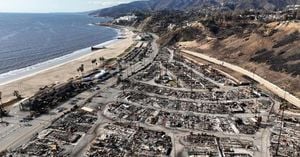In a year marked by relentless natural disasters and economic headwinds, Southeast Asia has found itself at a crossroads—balancing urgent humanitarian needs with the pursuit of economic stability. As Vietnam reels from a series of devastating typhoons and Thailand navigates a challenging economic landscape, both nations are turning to international partners, local communities, and corporate giants for support and resilience.
Vietnam, a country no stranger to the whims of nature, has faced an extraordinary barrage of storms in 2025. According to InfoQuest, since the beginning of the year, Vietnam has been struck by 11 typhoons, six of which made landfall, and an additional four tropical depressions. The human toll has been sobering: 238 people lost their lives, and nearly 400 sustained injuries. The destruction has extended far beyond personal tragedy, battering homes, farmland, and critical infrastructure.
The Vietnamese Ministry of Agriculture and Environment recently convened an emergency meeting in Hanoi with international organizations and foreign embassies to address the ongoing crisis. The agenda was clear: to report on the latest flooding and to appeal for international aid in relief and recovery efforts. Nguyen Hoang Hiep, Vietnam’s Deputy Minister of Agriculture and Environment, did not mince words about the gravity of the situation. He estimated the economic damage at roughly 35 trillion Vietnamese dong—about $1.3 billion USD. That’s nearly half the total damage recorded last year, and officials warn that the true cost may yet rise as affected regions continue to tally their losses.
“Natural disasters this year have been more complex and severe,” Hiep stated, underscoring a troubling trend. “Despite our best efforts to prevent and cope with these disasters, the intensity has exceeded the capacity of local communities and our existing defense systems.”
Vietnam’s economic expansion, so often a point of national pride, has not escaped unscathed. The Ministry projects a 0.2% reduction in the country’s gross domestic product (GDP) as a direct result of the disasters—a significant setback for a nation that has long relied on steady growth to lift millions out of poverty.
Adding to the challenge, the nature of these disasters is shifting. As Hiep explained, “The patterns of natural disasters have changed significantly. Some storms move quickly over the sea but slow down over land, causing prolonged heavy rainfall. Others strike northern provinces late in the season, which was rare in the past.” Such unpredictability complicates both preparedness and recovery, leaving communities vulnerable and response teams stretched thin.
International solidarity has played a crucial role in Vietnam’s recovery efforts. Last year, global partners contributed around $25 million in aid and thousands of tons of relief supplies, enabling hard-hit communities to begin rebuilding. This year, however, the scale and frequency of disasters have left Vietnam’s government urging for even more robust international engagement. The call for help is not just about immediate relief; it’s about fortifying the country against future calamities that, if trends continue, may become even more frequent and destructive.
Meanwhile, just across the border, Thailand is battling its own set of challenges. On October 10, 2025, the Bank of Thailand released figures showing that the country’s GDP growth for the third quarter stood at a modest 0.2%. While this growth was buoyed by private consumption and government spending, it was hardly the robust rebound many had hoped for. The export sector, a traditional engine of Thailand’s economy, showed tentative signs of recovery as demand from major trading partners edged upwards. Inflation, for its part, remained stable at 1.3% during the same period—a welcome bit of predictability in an otherwise turbulent year.
Despite these modest gains, the central bank’s outlook for the rest of 2025 is one of cautious optimism. The forecast calls for steady economic growth, but officials are all too aware of the vulnerabilities that remain. Natural disasters, shifting global markets, and the ongoing need for energy transition all loom large on the horizon.
In this climate, Thailand’s corporate sector has stepped up to play a vital role in both economic and humanitarian spheres. PTT Public Company Limited, the nation’s energy behemoth, held its 58th annual general meeting of shareholders on October 10. At the meeting, the company’s financial statements for the fiscal year ending 2025 were approved, and a dividend payment of 4,000 million baht was announced. More than just numbers, these decisions reflect a broader strategy aimed at sustainable growth and energy transition—a theme echoed repeatedly throughout the meeting.
But PTT’s commitment extends beyond boardroom strategy and shareholder returns. Throughout September, the company mobilized significant resources to support flood relief efforts in regions hardest hit by rising waters. Working in tandem with government agencies like the Department of Disaster Prevention and Mitigation in Phitsanulok Province, and local administrations in Ayutthaya, Nonthaburi, and Singburi, PTT distributed over 4,000 survival kits to affected families. For many, these kits—delivered to communities along the swollen Chao Phraya River—meant the difference between enduring hardship and finding hope.
“PTT is committed to supporting Thailand’s economic development and energy security,” the company emphasized in its public statements. This dual focus on immediate relief and long-term resilience is emblematic of a broader shift in corporate responsibility, as companies recognize the intertwined nature of economic health and social well-being.
The story unfolding in Vietnam and Thailand is, in many ways, a microcosm of the challenges facing Southeast Asia as a whole. Climate change is amplifying the frequency and severity of natural disasters, testing the limits of national preparedness and regional cooperation. At the same time, economic uncertainties—whether driven by global market fluctuations or domestic disruptions—demand agile, forward-thinking responses from governments and businesses alike.
For Vietnam, the road ahead will require not just international aid but also investment in disaster-resilient infrastructure, improved early warning systems, and stronger community networks. For Thailand, the challenge lies in sustaining economic momentum while ensuring that the most vulnerable are not left behind when disaster strikes.
As the region braces for what many experts warn could be more turbulent years ahead, the lessons of 2025 are clear: resilience is not built overnight, and recovery is rarely linear. It takes more than government action or corporate charity; it takes a whole-of-society commitment to weathering the storms—literal and figurative—that lie ahead.
In the face of adversity, both Vietnam and Thailand are finding ways to adapt, rebuild, and look to the future. Their experiences offer sobering reminders of the risks, but also glimpses of the resourcefulness and solidarity that will be needed in the years to come.




